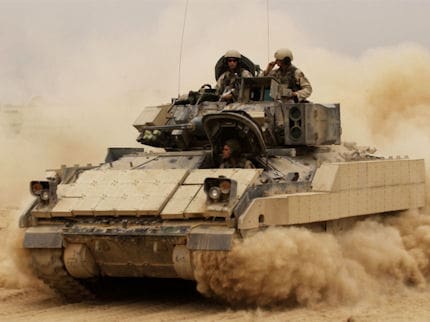“Lance Winslow“, online writer in retirement, came up with an interesting idea for camouflaging large numbers of vehicles quickly. In his article, “Spray on Dirt Research and Development” he suggest, “spray on dirt may be a concept worth research and development dollars.” His argument, which makes sense, is that development of an “arsenal” of simple solutions make fiscal sense in light of the high cost of a single armored vehicle. Specifically, his concept “consists of a unit with a small water tank and filler hose with a mini sump pump attachment [throw one end into a river, well, pool of left over rain water] to apply the sticky solution; the solution is fed into an inline injection on a 1.8 Hp Honda motor or an equivalent AC out put from a diesel generator with a military grade sprayer unit again totally KISS.”
However, I would say that “Lance” doesn’t have much in the way of military experience as in my recollection, tactical vehicles have no trouble collecting mud and dirt on their own. All you have to do is drive them around for a bit. In fact, most Sergeants Major would probably love to have the spray guns described in the proposal if only to clean the vehicles. But maybe a better material than plain old mud might be sprayed on vehicles that suppresses more than just a visual signature or helps deflect the blast of an IED.
Tags: irony, Tongue in Cheek



Its true that vehicles have no problem getting dirty on their own – but it takes a fair amount of driving around to get a good thick covering, and even then it usually doesn’t end up covering the top or higher areas of the vehicle very well.
Lance’s idea is really just a technologically enhanced version of an old idea: in the Second World War the Germans made field-expedient “camouflage” for their field grey vehicles on the Russian front by mixing up local mud in buckets and slapping it on with mops – or even just chucking the bucket full directly on to the vehicle. Some even got a bit artistic and replicated their splinter and splotchy camo patterns using this mud-over-base-coat-paint method.
I also believe that American tank crews in North Africa sometimes resorted to similar measures to make their OD tanks blend in better with the tan coloured landscape.
This idea was visited in Desert Storm. Many units didn’t have the resources to get their vehicles painted from the European theater hues to desert colors, so they did the field expedient method and sprayed glue onto their vehicles then threw the dust and sand on them.
It worked great for camo and thermal signature reduction, but after the war, the USDA threw a fit and mandated the complete removal of all soil from these vehicles before they could be shipped back.
I recall long lines of Army vehicles lined up waiting their turn for the wash rack to try valiantly to get that gunk off. I know because after the war they made us Military Customs Inspectors and we had to ensure that all the soild was removed.
This is some great feedback guys!
Really? Is there nothing else to cash in on? We are not modernizing our military yet somone’s “good idea fairy” moment makes news?
This is also a mechanized version of something snipers have been doing for years. You get your fancy camo net that is perfectly matched to your target environment. This is maybe a 50% solution. Then you attach natural vegetation to it and go the rest of the way. For those of us that are lazy an easy way to attach whatever is in your area is to use a spray glue on the net or camouflage and roll it in the area. For Fort Benning this gives you a nice collection of pine straw and dead leaves. For Iraq away from the rivers it gives you sand. Its an awesome and easy finisher but not a complete answer.
We (2/505PIR) had to cover our hard-top Hummers with thick mud before heading into Iraq in 91. No glue used, just water and dirt. The effect was stunning as the vehicles matched the surroundings in both color and texture.
Nothing new here, just over complicating a simple task. When Canadian units were sent to Somalia back in the 90’s, their LAV’s were still painted white from a previous Peace Keeping mission. A simple mixture of sand, dirt, and water was applied to add at least some camouflage. You want KISS? Can’t beat a bucket and some dirt.
SAAB/Barracuda camo-netting is available in many colours and has been shown to not only camoflague and reduce IR-signature, it also keeps inside temperatures down in the day.
During OIF-2 to cover our rusty “hillbilly” armor and make us blend in better we used the water/mud technique the Germans did in Afrika and Russia. We took water, added the Iraqi moon dust and applied it with a broom heavily to our vehicles. It stayed on for along time and only required touch ups during the rainy season.